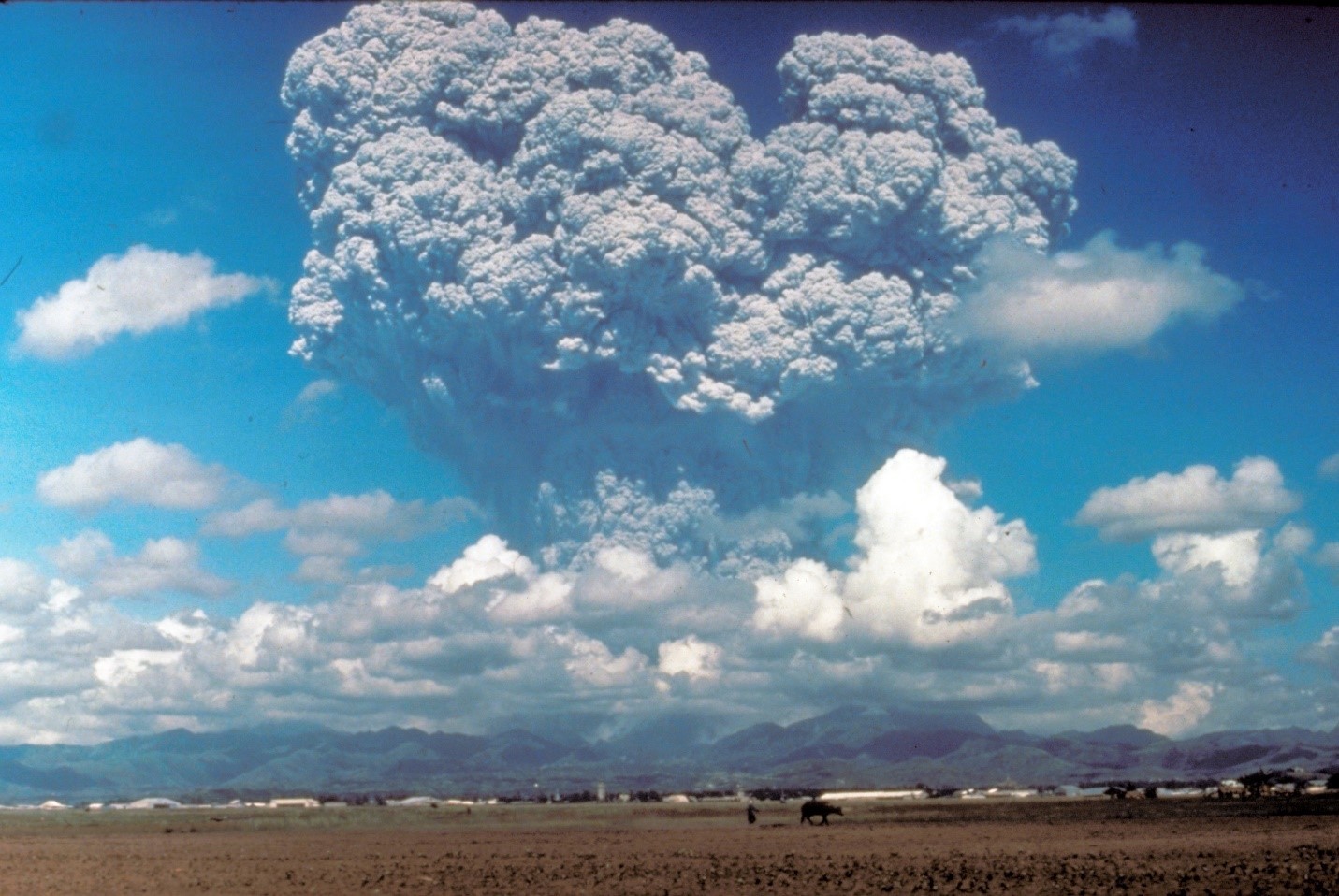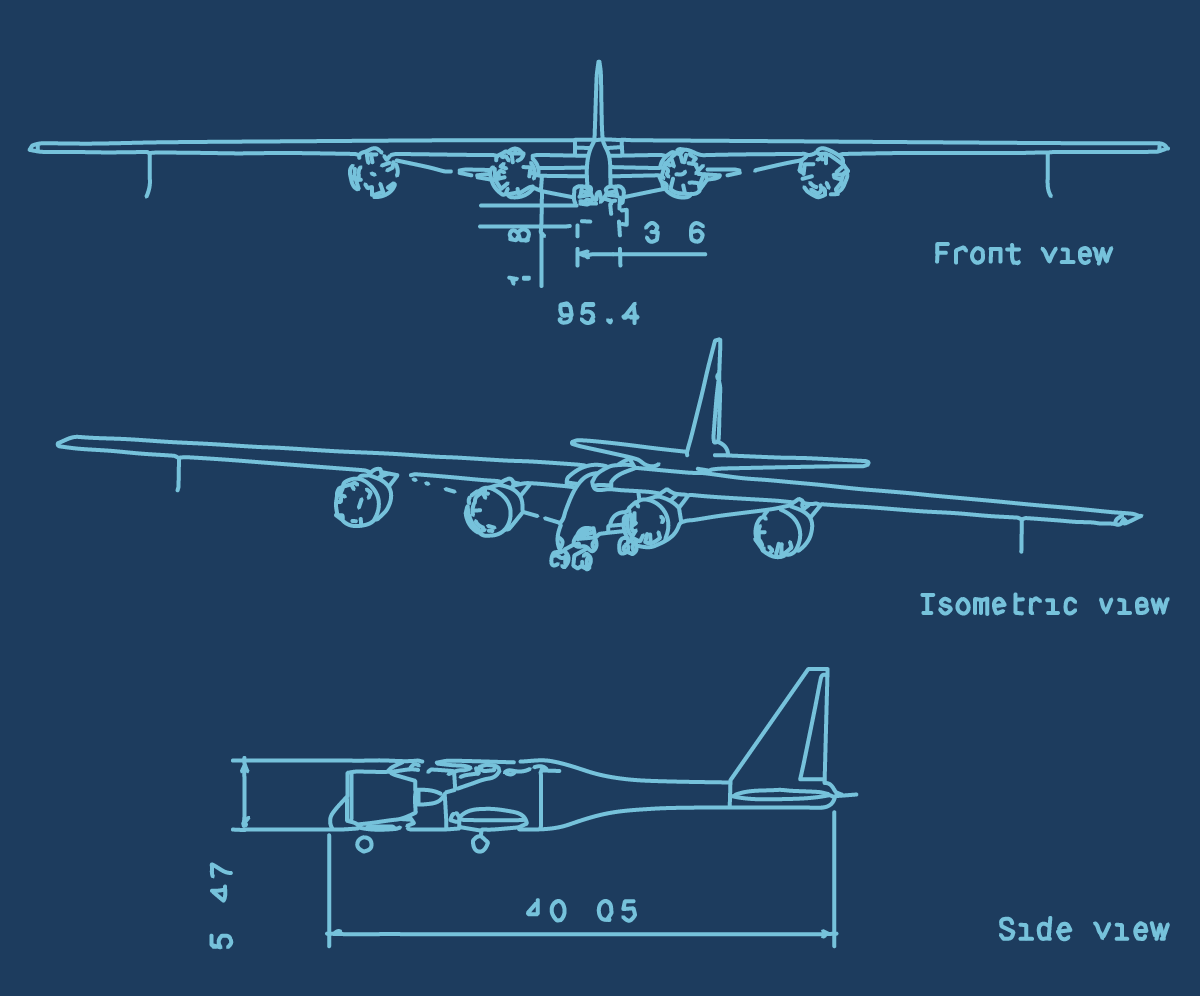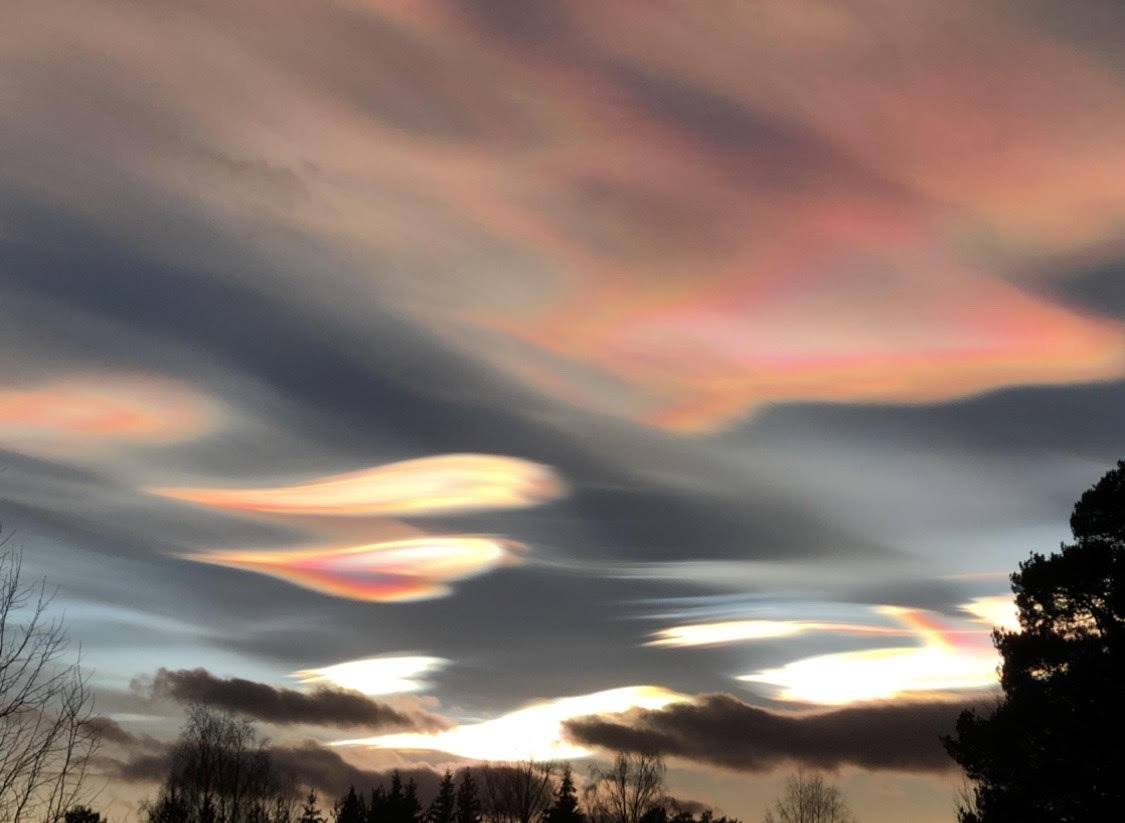Article
Stratospheric Aerosol Injection
Stratospheric aerosol injection (SAI) is an idea to create a layer of tiny reflective particles high in the atmosphere to reflect a small amount of sunlight. There is little doubt among researchers that implementing this idea would lower temperatures globally. But while it could limit some harms from climate change, it would also introduce new risks and pose serious challenges.
Key takeaways
- Scientists are confident that adding reflective particles to the stratosphere could halt or even reverse global warming and reduce the climate risks associated with warming.
- However, depending on how it is deployed, SAI would increase some climate risks in some places, and could have significant side effects.
- Whether and how to deploy SAI would be a choice with far-reaching, global consequences and one that presents substantial challenges and risks.
The eruption of Mt. Pinatubo in the Philippines in 1991 was one of the largest volcanic eruptions the world has seen in centuries. It also provided a compelling demonstration of the climate-altering potential of tiny particles suspended in the air – known as aerosols.
Pinatubo’s eruption was so explosive that its plume reached a height of more than 40 km, penetrating deep into the stratosphere – the stable layer of the atmosphere above most clouds that hosts the protective ozone layer. There, 14 to 20 million tonnes of sulphur dioxide from Pinatubo’s plume spread across the tropics and into both hemispheres,1 forming countless microscopic droplets of sulphuric acid and water – known as sulphate aerosol particles.
This thin, global aerosol layer reflected around 1% of incoming sunlight for roughly a year,2 acting like a parasol. The sky was a little whiter and sunsets a little brighter while it lasted. Global temperatures dipped by around 0.5°C in the year following Pinatubo’s eruption but would have fallen further had this layer persisted.
SAI is technically feasible
SAI is an idea to lower global temperatures in a similar way to such large volcanic eruptions. By creating a continually replenished layer of aerosol particles in the stratosphere, it is hoped that the climate impacts associated with rising temperatures could be reduced.
With the Paris Agreement, all countries pledged to cut their greenhouse gas emissions, but these pledges will not be sufficient to limit warming to 1.5°C above the pre-industrial level. Analysis by the United Nations Environment Programme suggests that even if the pledges for 2030 are met, the world is on track for around 2.5°C of warming by the end of the century.
Reflecting around 1% of incoming sunlight back to space would be sufficient to offset that 1°C difference.3 To achieve this using SAI would require releasing roughly 12 million tonnes of sulphur dioxide to the stratosphere each year.4
While there is uncertainty over how much cooling would be produced for every million tonnes of sulphur dioxide released, there is no doubt that releasing this material in the stratosphere would form a reflective layer of particles and that this would cool the planet.5
There is also little doubt that this would be technically feasible. To produce a global, stratospheric layer of aerosol particles would require releasing material at a height of around 20 km in the tropics or sub-tropics.6 This is far above the height most aircraft can fly, but engineering assessments are consistent in suggesting that this could be achieved using new, specially designed, high-altitude aircraft.6,7
Stratospheric aerosol injection
Stratospheric aerosol injection (SAI) is an idea to lower the global temperature by dispersing tiny particles in the stratosphere to reflect a small fraction of sunlight. These reflective particles would remain in the stratosphere for 1-2 years, rather than the few days they would last in the lower atmosphere, because the stratosphere is stable and dry.

SAI would be a global intervention.
Wherever particles were released in the stratosphere, strong winds would spread them out east-west around the world and then towards the poles.
Sunlight
The stable stratosphere
The stratosphere is dry and the temperature increases with height. As a result, there are very few clouds in the stratosphere and it is stable. This means particles can persist for a few years before they eventually drop into the troposphere.
Warmer air
Cooler air
The turbuluent troposphere
The lowermost part of the atmosphere, the troposphere, is turbulent and humid. Particles remain in the troposphere for only a few days before they either settle to the ground or are caught up in clouds and rained out.
Warm air
Cool air

Stratospheric aerosol injection
Stratospheric aerosol injection (SAI) is an idea to lower the global temperature by dispersing tiny particles in the stratosphere to reflect a small fraction of sunlight. These reflective particles would remain in the stratosphere for 1-2 years, rather than the few days they would last in the lower atmosphere, because the stratosphere is stable and dry.
SAI would be a global intervention.
Wherever particles were released in the stratosphere, strong winds would spread them out east-west around the world and then towards the poles.
Sunlight
Warmer air
The stable stratosphere
The stratosphere is dry and the temperature increases with height. As a result, there are very few clouds in the stratosphere and it is stable. This means particles can persist for a few years before they eventually drop into the troposphere.
Cooler air
The turbuluent troposphere
Warm air
The lowermost part of the atmosphere, the troposphere, is turbulent and humid. Particles remain in the troposphere for only a few days before they either settle to the ground or are caught up in clouds and rained out.
Cool air

Stratospheric aerosol injection (SAI) is an idea to lower the global temperature by dispersing tiny particles in the stratosphere to reflect a small fraction of sunlight. These reflective particles would remain in the stratosphere for 1-2 years, rather than the few days they would last in the lower atmosphere, because the stratosphere is stable and dry.
SAI would be a global intervention.
Wherever particles were released in the stratosphere, strong winds would spread them out east-west around the world and then towards the poles.
Sunlight
The stable stratosphere
The stratosphere is dry and the temperature increases with height. As a result, there are very few clouds in the stratosphere and it is stable. This means particles can persist for a few years before they eventually drop into the troposphere.
Warmer air
Cooler air
The turbuluent troposphere
The lowermost part of the atmosphere, the troposphere, is turbulent and humid. Particles remain in the troposphere for only a few days before they either settle to the ground or are caught up in clouds and rained out.
Cool air
Warm air
The environmental impacts of SAI
SAI could not only lower the global average temperature, but by adjusting the locations and amounts of material released, it could more-or-less evenly cool the planet.8 Many of the risks of climate change are closely connected to rising temperatures and so, by evenly cooling the planet, SAI could reduce those risks. For example, extremes of heat and rain,9 the melting of sea ice and permafrost,10 and sea level rise11,12 are projected to be reduced in most if not all places.
However, SAI could not offset all aspects of climate change this well. In particular, the global hydrological cycle would be markedly different if SAI were deployed.13 While climate modelling studies suggest that there would be less overall change in rainfall with SAI compared to climate change alone, some regions would see more change which may prove harmful.14
In addition to imperfectly offsetting the effects of climate change, SAI would come with several side effects.
Any material released into the stratosphere would fall back to Earth within a couple of years, requiring consistent releases to maintain the cooling effect. If sulphates were used, this would add to acid rain, though only adding fractionally to the existing problem.
A persistent sulphate layer would also change the stratosphere. The particles would not only reflect light back to space, but also scatter it, making the sky a little hazier. They would also absorb heat, warming the stratosphere and changing stratospheric wind patterns.15
SAI would add particles to the stratosphere, changing its chemistry and affecting the ozone layer, which protects the world from harmful ultraviolet rays. If sulphate particles were used, this might slow the recovery of the ozone hole by up to several decades.4
These side effects are motivating research into alternative particles for SAI that might not have these same problems.16 For example, particles like calcite (chalk dust) could reflect light but might do so without having as great an impact on the ozone layer. However, much less is known about these alternatives.
SAI would not address the underlying causes of climate change
The world is warming primarily due to the buildup of greenhouse gases in the atmosphere, and SAI would do little to change this.17 Neither would it directly change the effects of carbon dioxide building up in the oceans, which is acidifying them and harming ocean ecosystems.
However, there are concerns that developing and deploying sunlight reflection methods like SAI could undermine efforts to cut emissions – a concern known as “moral hazard” or mitigation displacement. This would lead to increased ocean acidification and generally a greater amount of global warming to offset or endure.
Furthermore, the cooling effect of particles in the stratosphere lasts for only a couple of years, while the warming effect of carbon dioxide would decline slowly over the course of thousands of years.18 If large-scale SAI deployment were suddenly halted, a rapid warming would follow – commonly referred to as a “termination shock”.19 Large-scale SAI deployment would therefore come with a long-term commitment.
Deciding whether and how to deploy SAI
SAI appears to offer a technically feasible means of halting rising temperatures which could reduce many climate risks, while worsening some risks in some places. This means that deciding whether and how to deploy SAI would have global impacts and far-reaching implications.
What ethical principles should shape such decisions? Is interfering in the climate system in this way justified by the impacts of climate change? What obligations would those who deploy SAI have for those harmed by it?
While there might be ideal answers to such questions, substantial governance challenges may make it difficult to implement them in the real world. Which countries would be involved in decisions on deployment and what will shape their choices? What geopolitical risks could come with SAI, if it is pursued unilaterally by a narrow coalition of countries?
Making wise decisions on SAI and other sunlight reflection methods will require careful consideration of these and other difficult questions, and a cooperative effort to find answers.
Open questions
- Which regions stand to gain and lose under SAI, and how does that compare to the winners and losers under climate change?
- Could alternative aerosol particles, like calcite, offer reduced side effects and risks compared to sulphate particles?
- How might countries cooperate over research into SAI, and make informed decisions over whether and how to develop and deploy it in future?
Ask us a question!
Endnotes
- Stenchikov G, Ukhov A, Osipov S, et al. (2021). How Does a Pinatubo-Size Volcanic Cloud Reach the Middle Stratosphere? J Geophys Res Atmospheres. 126(10):e2020JD033829. https://doi.org/10.1029/2020JD033829
- Pinatubo’s eruption increased aerosol optical depth – a measure of how much light is blocked by aerosols in the atmosphere – by roughly 0.1,20 which corresponds approximately to decreasing incoming sunlight by 1%.21
- Visioni D, MacMartin DG, Kravitz B, et al. (2021). Identifying the sources of uncertainty in climate model simulations of solar radiation modification with the G6sulfur and G6solar Geoengineering Model Intercomparison Project (GeoMIP) simulations. Atmospheric Chem Phys. 21(13):10039–63. https://doi.org/10.5194/acp-21-10039-2021
- Haywood J, Tilmes S, Keutsch F, et al. (2022). Chapter 6: Stratospheric Aerosol injection and its Potential Effect on the Stratospheric Ozone Layer. In: Scientific Assessment of Ozone Depletion 2022. pp. 325–375. https://csl.noaa.gov/assessments/ozone/2022/downloads/Chapter6_2022OzoneAssessment.pdf
- Kravitz B, MacMartin DG. (2020). Uncertainty and the basis for confidence in solar geoengineering research. Nature Reviews Earth & Environment. 1(1):64-75. https://doi.org/10.1038/s43017-019-0004-7
- Smith W. (2020). The cost of stratospheric aerosol injection through 2100. Environmental Research Letters. 15(11):114004. https://doi.org/10.1088/1748-9326/aba7e7
- Lockley A, MacMartin D, Hunt H. (2020). An update on engineering issues concerning stratospheric aerosol injection for geoengineering. Environmental Research Communications. 2(8):082001. https://doi.org/10.1088/2515-7620/aba944
- Kravitz B, MacMartin DG, Tilmes S, et al. (2019). Comparing surface and stratospheric impacts of geoengineering with different SO2 injection strategies. Journal of Geophysical Research: Atmospheres. 124(14):7900-18. https://doi.org/10.1029/2019JD030329
- Ji D, Fang S, Curry CL, et al. (2018). Extreme temperature and precipitation response to solar dimming and stratospheric aerosol geoengineering. Atmospheric Chemistry and Physics. 18(14):10133-56. https://doi.org/10.5194/acp-18-10133-2018
- Duffey A, Irvine P, Tsamados M, et al. (2023). Solar geoengineering in the polar regions: A review. Earth’s Future. 11(6):e2023EF003679. https://doi.org/10.1029/2023EF003679
- Moore JC, Greve R, Yue C, et al. (2023). Reduced ice loss from Greenland under stratospheric aerosol injection. Journal of Geophysical Research: Earth Surface. 128(11):e2023JF007112. https://doi.org/10.1029/2023JF007112
- Yue C, Jevrejeva S, Qu Y, et al. (2023). Thermosteric and dynamic sea level under solar geoengineering. npj Climate and Atmospheric Science. 6(1):135. https://doi.org/10.1038/s41612-023-00466-4
- Ricke K, Wan JS, Saenger M, et al. (2023). Hydrological consequences of solar geoengineering. Annual review of earth and planetary sciences. 51(1):447-70. https://doi.org/10.1146/annurev-earth-031920-083456
- Irvine PJ, Keith DW. (2020). Halving warming with stratospheric aerosol geoengineering moderates policy-relevant climate hazards. Environmental Research Letters. 15(4):044011. https://doi.org/10.1088/1748-9326/ab76de
- Aquila V, Garfinkel CI, Newman PA, et al. (2014). Modifications of the quasi‐biennial oscillation by a geoengineering perturbation of the stratospheric aerosol layer. Geophysical Research Letters. 41(5):1738-44. https://doi.org/10.1002/2013GL058818
- Keith DW, Weisenstein DK, Dykema JA, et al. (2016). Stratospheric solar geoengineering without ozone loss. Proceedings of the National academy of Sciences. 113(52):14910-4. https://doi.org/10.1073/pnas.1615572113
- By lowering global temperatures, SAI could enhance the uptake and retention of carbon by the land and ocean,22 for example, by reducing the release of carbon from melting permafrost.10
- Archer D, Eby M, Brovkin V, et al. (2009). Atmospheric lifetime of fossil fuel carbon dioxide. Annual review of earth and planetary sciences. 37(1):117-34. https://doi.org/10.1146/annurev.earth.031208.100206
- Parker A, Irvine PJ. (2018). The risk of termination shock from solar geoengineering. Earth’s Future. 6(3):456-67. https://doi.org/10.1002/2017EF000735
- Long CS, Stowe LL. (1994). Using the NOAA/AVHRR to study stratospheric aerosol optical thicknesses following the Mt. Pinatubo eruption. Geophysical research letters. 21(20):2215-8. https://doi.org/10.1029/94GL01322
- Visioni D, MacMartin DG, Kravitz B. (2021). Is turning down the sun a good proxy for stratospheric sulfate geoengineering?. Journal of Geophysical Research: Atmospheres. 126(5):e2020JD033952. https://doi.org/10.1029/2020JD033952
- Tjiputra JF, Grini A, Lee H. (2016). Impact of idealized future stratospheric aerosol injection on the large‐scale ocean and land carbon cycles. Journal of Geophysical Research: Biogeosciences. 121(1):2-7. https://doi.org/10.1002/2015JG003045
Citation
Reuse this work freely
All visualisations, data, and code produced by SRM360 are open access under the Creative Commons BY license. You are free to use, distribute, and reproduce these in any medium, provided that SRM360 and the authors are credited.
Data produced by third parties and made available by SRM360 is subject to the licence terms of the original third-party authors. We will always indicate the original source of such data in our documentation, so please review the licence of any third-party data before use and redistribution.




